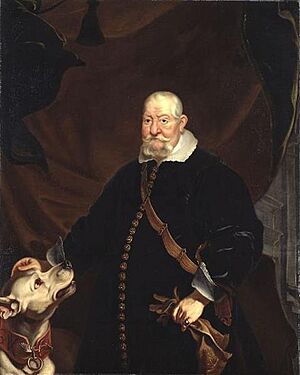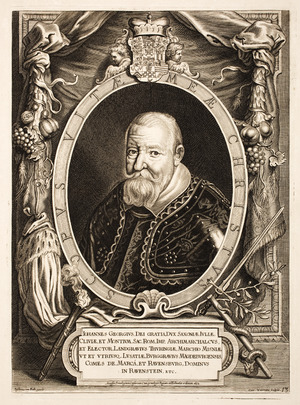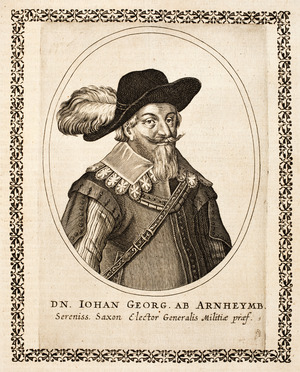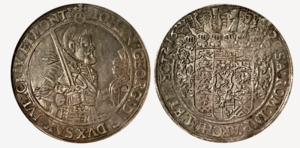John George I, Elector of Saxony facts for kids
Quick facts for kids John George I |
|
|---|---|

John George I in 1652, portrait by Frans Luycx
|
|
| Elector of Saxony | |
| Reign | 23 June 1611 – 8 October 1656 |
| Predecessor | Christian II |
| Successor | John George II |
| Born | 5 March 1585 Dresden, Electorate of Saxony, Holy Roman Empire |
| Died | 8 October 1656 (aged 71) Dresden, Electorate of Saxony, Holy Roman Empire |
| Burial | Freiberg Cathedral |
| Spouse |
Sibylle Elisabeth of Württemberg
(m. 1604; died 1606)Magdalene Sibylle of Prussia
(m. 1607) |
| Issue | Sophie Eleonore, Landgravine of Hesse-Darmstadt Marie Elisabeth, Duchess of Holstein-Gottorp John George II, Elector of Saxony August, Duke of Saxe-Weissenfels Christian I, Duke of Saxe-Merseburg Magdalene Sibylle, Duchess of Saxe-Altenburg Maurice, Duke of Saxe-Zeitz |
| House | House of Wettin |
| Father | Christian I, Elector of Saxony |
| Mother | Sophie of Brandenburg |
| Religion | Lutheran |
John George I (born March 5, 1585 – died October 8, 1656) was the Elector of Saxony from 1611 to 1656. He ruled Saxony during the Thirty Years' War, a very important and difficult time. This war shaped most of his 45-year reign.
Contents
Life as Elector of Saxony
John George was born in Dresden. He was the second son of Elector Christian I and Sophie of Brandenburg. His family belonged to the Albertine line of the House of Wettin, a powerful German noble family.
Becoming Elector
John George became Elector on June 23, 1611. This happened after his older brother, Christian II, passed away. Saxony was an important region in Germany. Its location made its ruler very influential during the Thirty Years' War.
At first, John George tried to stay neutral. He was a strong Lutheran, but he didn't like how powerful Brandenburg-Prussia and the Palatinate were becoming. He thought Saxony should support the Habsburgs and the Roman Catholic side.
Early Decisions in the War
In August 1619, John George voted for Ferdinand of Styria to become emperor. This surprised many Protestant leaders. Ferdinand promised John George that he could keep certain church lands.
John George helped Ferdinand by taking over Silesia and Lusatia. He was kind to the people there. His actions helped remove Frederick V from Bohemia. This also weakened Protestantism in that country. John George had actually refused the crown of Bohemia himself earlier.
Growing Concerns
Over time, John George became worried. He saw that the emperor's plan was to crush Protestantism. He also feared losing the church lands he had gained. The Edict of Restitution in March 1629 made his fears even stronger. This Edict ordered that all church lands taken by Protestants since 1552 be returned to the Catholic Church.
John George asked for Saxony to be free from this Edict. However, he did not break his alliance with the emperor. In February 1631, he called a meeting of Protestant princes in Leipzig. But he only made a formal protest, not a strong stand.
Joining the Protestants
Meanwhile, Gustavus Adolphus, the King of Sweden, arrived in Germany. He wanted to help the city of Magdeburg. Gustavus tried to make an alliance with John George. He wanted to cross the Elbe river at Wittenberg. But John George was still unsure about joining the Protestant cause.
Tilly, the commander of the emperor's army, was worried about this possible alliance. To stop it, he invaded Saxony. Tilly's army started to destroy the countryside. This invasion actually pushed John George into the alliance he had tried to avoid. The alliance was made in September 1631.
Battles and Peace
Saxon troops fought at the Battle of Breitenfeld. However, they were defeated by Tilly's imperial forces. John George himself fled for safety.
After Gustavus Adolphus defeated Tilly's army, John George went on the attack. His Saxon army took Prague in Bohemia. But John George soon started to talk about peace. His soldiers offered little resistance when Wallenstein pushed them back into Saxony.
Gustavus Adolphus's efforts kept John George from leaving the alliance. But things changed when Gustavus died at the Battle of Lützen in 1632. Saxony then refused to join the Protestant league led by Sweden.
End of the War
John George continued to fight the imperial forces. He also kept negotiating for peace. In May 1635, he signed the important Treaty of Prague with Ferdinand II.
As a reward, he gained Lusatia and other lands. His son Augustus was allowed to keep the Archbishopric of Magdeburg. There were also some agreements about the Edict of Restitution.
Almost immediately, John George declared war on the Swedes. But in October 1636, he was defeated at the Battle of Wittstock. Saxony suffered greatly, as both sides ravaged the land.
Finally, in September 1645, John George had to agree to a truce with the Swedes. They kept Leipzig. For Saxony, this marked the end of the Thirty Years' War. After the Peace of Westphalia, which mostly confirmed the Treaty of Prague, John George passed away on October 8, 1656.
Legacy and Character
John George I was a ruler with political skill. However, he is not remembered as one of the greatest leaders. His personality was seen as stern. He also enjoyed hunting and other pastimes. Wallenstein, a famous general, did not have a high opinion of him.
Family and Children
John George was married two times. Besides his successor, John George II, he had three other sons: Augustus (1614–1680), Christian (died 1691), and Maurice (died 1681).
First Marriage
In Dresden on September 16, 1604, John George first married Sibylle Elisabeth of Württemberg. She was the daughter of Frederick I, Duke of Württemberg. She died giving birth to their only child:
- Stillborn son (Dresden, January 20, 1606)
Second Marriage
In Torgau on July 19, 1607, John George married Magdalene Sibylle of Prussia. She was the daughter of Albert Frederick, Duke of Prussia. They had ten children:
- Stillborn son (Dresden, July 18, 1608)
- Sophie Eleonore (born Dresden, November 23, 1609 – died Darmstadt, June 2, 1671). She married George II, Landgrave of Hesse-Darmstadt on April 1, 1627.
- Marie Elisabeth (born Dresden, November 22, 1610 – died Husum, October 24, 1684). She married Frederick III, Duke of Holstein-Gottorp on February 21, 1630.
- Christian Albert (born Dresden, March 4, 1612 – died Dresden, August 9, 1612)
- John George II (born Dresden, May 31, 1613 – died Freiberg, August 22, 1680). He became Elector of Saxony after his father.
- Augustus (born Dresden, August 13, 1614 – died Halle, August 4, 1680). He inherited Weissenfels as Duke.
- Christian I (born Dresden, October 27, 1615 – died Merseburg, October 18, 1691). He inherited Merseburg as Duke.
- Magdalene Sibylle (born Dresden, December 23, 1617 – died Schloss Altenburg, January 6, 1668). She married Crown Prince Christian on October 5, 1634. She later married Frederick William II, Duke of Saxe-Altenburg on October 11, 1652.
- Maurice (born Dresden, March 28, 1619 – died Moritzburg, December 4, 1681). He inherited Zeitz as Duke.
- Henry (born Dresden, June 27, 1622 – died Dresden, August 15, 1622)
See also
 In Spanish: Juan Jorge I de Sajonia para niños
In Spanish: Juan Jorge I de Sajonia para niños
- List of big-game hunters






